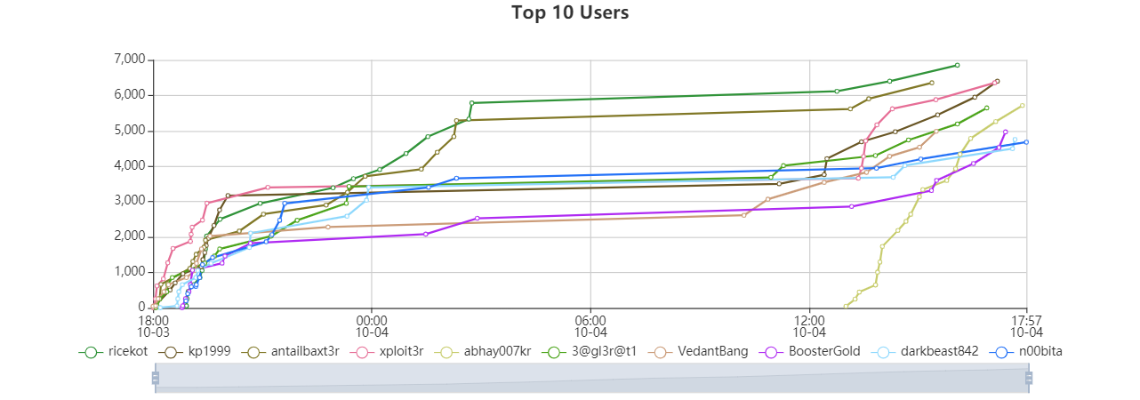CTE TechWeekend CTF 2020
I spent the past weekend solving challenges from CTE TechWeekend CTF, and I had a blast. The difficulty of the challenges was just above what I’m used to, but I managed to solve them all and bag first place 😀. Thanks to the organisers, Team BITSKrieg and CTE for organising this lovely event!

Since this is the first time I’m writing a CTF writeup, I decided to follow the tips given here.
Here’s my approach to some challenges that I had the most fun with:
1.
| Challenge Name: | fives…fives…fives |
|---|---|
| Challenge Description: | What Is Seen Is Temporary, But What Is Unseen Is Eternal. |
| Challenge Category: | Reverse Engineering |
| Challenge Points: | 497 |
| TL; DR: | Use Ghidra to analyse the provided binary and rewrite logic in Python. |
The first thing I did was check the file type. Then, I imported it into Ghidra’s CodeBrowser and looked at the decompiled code for the main function. The program basically performed some operations on a hardcoded array, and then checked the input against it. If we passed the flag to the program, it would congratulate us. At the time, I simply wrote the decompiled code in Python - which was about 27 lines - without thinking too much about it. However, when writing this post, I realised that the operation was actually pretty straightforward, and it also explained the challenge name and the flag:
arr = [0x195, 0x140, 0x15e, 0x181, 0x19a, 0x186, 0x177, 0x145, 0x276, 0xf0,
0x235, 0xf5, 0x26c, 0x1c2, 0x181, 0x109, 0x208, 0x10e, 0x1c2, 0x177,
0x1c2, 0xf0, 0x235, 0xf5, 0x26c, 0x1c2, 0x1d1, 0x109, 0x1b3, 0x1b3,
0x10e, 0x1e5, 600]
print(''.join([chr(int(i/5)^5) for i in arr]))
TECHWKND{5t4y_H0m3_N_5t4y_X0RR3d}
What I’d like to do next: Read about reverse engineering, learn assembly, improve my code reading comprehension.
2.
| Challenge Name: | My Private Message |
|---|---|
| Challenge Description: | I forget what the opposite of compile was. I’m sure it was something-compile. |
| Challenge Category: | Cryptography |
| Challenge Points: | 448 |
| TL; DR: | Decompile the given .pyc file, convert the hardcoded array as: decimal -> hex -> ASCII. |
I felt that this challenge was similar to the above one. I decompiled the given “message.pyc” file by uploading it to python-decompiler.com. The program encrypted the input string and compared it against a hardcoded array. It was just a matter of figuring out the encryption algorithm. The input string was being converted to hexadecimal which was then converted to decimal. The decryption algorithm was just the reverse of this.
encoded = [361939290199, 323435658101, 474110520688, 521506348907,
473259521375, 512849360735, 212055061040, 237085094704,
409954706557]
print(bytearray.fromhex(''.join([hex(i)[2:] for i in encoded])).decode())
TECHWKND{unc0mpyl3_kn0w5_wh47_1_wr073_s0_s4d}
It seems from the flag that they expected me to use a package called uncompyle to decompile the given file.
What I’d like to do next: Read about the implementation of uncompyle.
3.
| Challenge Name: | The Bourne Identity |
|---|---|
| Challenge Description: | Jesus Christ, it’s JSON Bourne |
| Challenge Category: | Web |
| Challenge Points: | 257 |
| TL; DR: | Inject JSON to overwrite the “admin” value. |
From the provided index.js file, here is all we need to solve the challenge:
var data= '{"admin":"no", "user":"'+request.body.uname+'", "pass":"'+request.body.psw+'"}';
var obj= JSON.parse(data)
var hash= crypto.MD5(obj.pass)
if (obj.user=="\x4a\x42\x6f\x75\x72\x6e\x65" && hash=="a883241dd51bda403ae5d9eb14e41331")
{
if(obj.admin=="yes")
{
response.send('<h2>ACCESS GRANTED</h2><br><p>'+process.env.FLAG+'</p>');
}
}
Converting the username from hex to ASCII and decrypting the MD5 hash, we get the following user credentials:
user: JBourne
pass: mattdamon
However, this isn’t enough. We also need to somehow set obj.admin="yes". If we provide the following credentials,
user: JBourne", "admin":"yes
pass: mattdamon
Here’s what the variable data would look like:
data = '{"admin":"no", "user":"JBourne", "admin":"yes", "pass":"mattdamon"}';
This will get us the flag,
TECHWKND{b0uRN3_2_h4Ck_Gq9jh}
Note that we cannot inject JSON in place of the password, because it is being hashed and compared.
I liked these challenges because these couldn’t be solved with just a tool and required some thinking. I used many tools in this competition, and I would like to read more about their implementations next. All in all, I think this CTF was a great experience and I would definitely participate again.